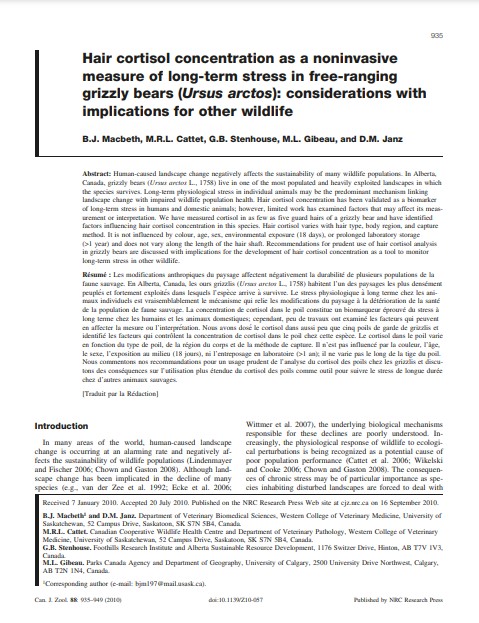Hair cortisol concentration as a noninvasive measure of long-term stress in free-ranging grizzly bears (Ursus arctos): Considerations with implications for other wildlife
Bosque Modelo:
Foothills
Temática:
Conservación
Tipo de documento:
Artículo científico
Resumen
Human-caused landscape change negatively affects the sustainability of many wildlife populations. In Alberta, Canada, grizzly bears (Ursus arctos L., 1758) live in one of the most populated and heavily exploited landscapes in which the species survives. Long-term physiological stress in individual animals may be the predominant mechanism linking landscape change with impaired wildlife population health. Hair cortisol concentration has been validated as a biomarker of long-term stress in humans and domestic animals; however, limited work has examined factors that may affect its measurement or interpretation. We have measured cortisol in as few as five guard hairs of a grizzly bear and have identified factors influencing hair cortisol concentration in this species. Hair cortisol varies with hair type, body region, and capture method. It is not influenced by colour, age, sex, environmental exposure (18 days), or prolonged laboratory storage (>1 year) and does not vary along the length of the hair shaft. Recommendations for prudent use of hair cortisol analysis in grizzly bears are discussed with implications for the development of hair cortisol concentration as a tool to monitor long-term stress in other wildlife.
Información Bibliográfica
Autor:
Macbeth, B.J., Cattet, M.R.L., Stenhouse, G.B., Gibeau, M.L., & Janz, D.M.
Revista:
Canadian Journal of Zoology
Año:
2010
N°:
-
País :
Canadá
Páginas:
935 - 949
Volumen:
88
Idioma:
Ingles
Palabras claves
Hair, Bears, cortizol





